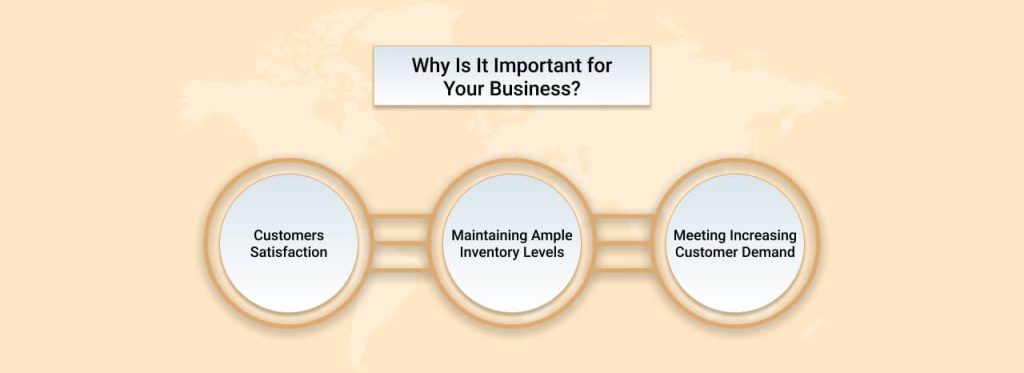Imagine you have spent a fortune and plenty of resources running countless campaigns over various channels to promote your products. And finally, when you have successfully created a hype and customers are looking for the product, your worst nightmare comes true when your products run out of stock. Such a situation may arise due to the lack of a proper demand planning strategy.

Explore Fulfillment Hub USA’s demand planning, inventory management, and fulfillment services.
Table of contents
What is Demand Planning?
Demand planning is an integral part of supply chain management that enables an organization to forecast future demand and effectively optimize the organization’s output based on the demand forecast. Explicitly, demand planning is the process of adjusting product or service availability according to the demand anticipation.
The main purpose of demand planning is to maintain a proper supply and demand balance, meaning the store inventory is supposed to contain just as many products as the demand side seeks. There is a thin line between sufficiency and surplus, and demand planning strives to achieve that thin line in an organization. Demand planning also includes constant marketing and promotional efforts to increase demand for the products or services.
Why Is It Important for Your Business?
For online stores and e-commerce sites that have just started, demand planning may not be necessary at this stage. But it is absolutely essential for a rapidly growing e-commerce business. Still wondering whether you should really implement a demand planning strategy? The following points might change your mind.

To Keep Customers Satisfied
It is hard to retain a customer once they have had a bad experience with your online store. However, with a solid demand planning strategy, you can ensure that your customers keep coming back for more.
For any business, keeping its customers happy is priority number one. And would your customers be happy and satisfied with your business if it cannot fulfill their demands?
Therefore, it is essential to avoid customer dissatisfaction and retain customers.
To Maintain Ample Inventory Levels
Demand planning allows you to be aware of exactly how much stock you need to hoard. So that your bestselling products never run out of stock when you need them the most. With a proper demand planning strategy, you will be able to order a new batch of stock at your supplier before your inventory runs dry.
For Meeting Increasing Customer Demand
E-commerce business is like a herd of sheep; it grows at a meteoric rate under optimum conditions. Demand planning will help you keep up with the rising customer demand when you have started getting traction in your e-commerce business with more customers looking for your products and increasing product demand.
Steps Involved in Demand Planning Process
Demand planning in itself is a vast subject. It will become vague if we don’t break down the complex demand planning process into smaller, more understandable elements.
Collecting Past Data
It all starts from here – Collecting data!
Putting together the past data of your business enables demand planners to understand products’ demand patterns from a historical perspective. Demand planners research both internal and external factors to gather the necessary information to forecast demand.
Internal sources are company sales, customer trends, seasonal data, and historical sales. On the other hand, external factors that impact the demand for a product include but are not limited to labor force change, natural disasters, pandemics, economic shifts, global crisis, etc.
Modeling Past Data
Creating a demand prediction by feeding your company’s past data to an algorithm or an artificial intelligence built to predict the future demand for your products.
Weighing Demand Forecast Against Inventory
This is where the magic of demand planning happens; in this step, planners realize how much stock they need in order to hoard to match the demand, including a little bit extra as buffer stock.
Trade Promotion
Trade promotion in terms of demand planning is a process that exists between retailers/wholesalers and manufacturers rather than the end customer.
It refers to the various methods of marketing and promotion directed towards retailers by manufacturers to increase the demand in retail stores.
Trade promotion offers retailers special discounts, free display racks, gifts, incentives to keep good relations with retailers.
Product Life Cycle Management
Product life cycle management is the process of managing the product’s lifecycle right from its introduction to retirement. It plays a vital role in demand planning since it allows demand planners to understand the impact a new product has on its existing product.
Replenishment Planning
Replenishment planning is the process of balancing the inventory level with the demand. In layman’s terms, the process of reordering or restocking your inventory to exactly match the demand. However, replenishment planning is not just limited to reordering your stock. It also helps you understand the stock level necessary to avoid building up surplus products.
In addition, replenishment planning tells demand planners exactly when to place an order, considering the time required by the supplier to deliver the products to you. With the help of replenishment planning, you will be able to restock your inventory before it runs out.
Popular Demand Forecasting Models
Speaking succinctly, demand forecasting methods are broadly categorized as qualitative and quantitative. Generally, qualitative demand forecasting methods are implemented by businesses when historical sales data does not exist. On the contrary, in the quantitative forecasting method, advanced technologies like machine learning and artificial intelligence churn out mountains of data to predict the future demand of your product.
Trend Projection
Trend projection is the method in which the sales data of the last few fiscal years (minimum 2-3 years) is used to predict the future demand for a product. It is the easiest and most straightforward method of demand prediction.
Trend projection forecasting, however, has its own limitation – Unexpected Changes! This forecasting model does not include some external factors that affect the sales of a product, like a natural disaster or a pandemic in the equation.
Sales Force Composite
Sales force composite is a forecasting method in which the demand forecast of a product is generated by consolidating the number of products each salesperson of your company is expecting to sell in their respective regions. Since salesforce composite predicts the demand based on the opinions of salesmen, it makes it a little less credible.
Let me explain how – First things first, a salesperson has no knowledge or experience in forecasting demand. In addition, the lack of data limits their ability to create fact-based forecasting.
Delphi Method
The Delphi method is used to deduce a unanimous opinion of a panel of industry experts. This technique helps create a demand prediction based on the subjective opinion of the expert panel. The feedback of the expert panel is recorded through a series of questionnaires and surveys.
Market Research
Ideal for new and budding businesses that don’t have historical data at their disposal, market research forecasting uses consumer feedback to forecast demand. Market research forecasting is entirely dependent on consumer feedback. The information collected through the feedback provides reliable insights on personal, demographic, economic, and geographic consumer preferences.
Econometrics
Econometrics is a quantitative forecasting method that uses big data to predict demand. It takes into account larger external factors that affect the consumer’s buying behavior. Machine learning and artificial intelligence make econometric forecasting possible. Econometric forecasting puts light on factors like an economic crisis or stock market crash, and their effect on consumers’ buying behavior.
Future of Demand Planning
Advancement in technologies is taking demand planning to the next level. For example, technologies like machine learning and AI are constantly helping demand planners to forecast demand faster and more accurately.
And needless to say, there are definitely going to be more advancements in technology which eventually will help streamline the whole demand planning process.
Even the internet of things (IoT) can make demand planning much easier by giving real-time updates of the inventory so that demand planners can plan accordingly and successfully maintain a lean inventory.
Summing up
Demand planning is a complex process with many interdependent factors at aggregated levels. It is among those critical processes that shape the growth of the company. Further, It is just as important as any other process in your company.
Not recommended for businesses in the early growth stage, However for businesses that have gained traction and are selling their products like hotcakes, demand planning is a must. Otherwise, without a proper demand planning strategy, your business will experience stock-outs. And stock outs lead to unsatisfied customers, and unsatisfied customers are bad for business.
Plan and Manage your Demand Efficiently with Fulfillment HUB USA
Are you a business that is striving to succeed but is held back due to limitations related to shipping, inventory management, warehouse management, or order management? If that’s the case, Fulfillment Hub USA can put you and your business out of misery. We offer state-of-the-art 5 in 1 cloud-based software solutions that are designed and developed to make fulfillment easy and efficient.
Our 5 in 1 cloud-based software solution is designed to assist you in the 5 most important aspects of an e-commerce business:
- Inventory Management
- Order management
- Shipping management
- Warehouse management
- Integration management.
You will be delighted to know that our software can be easily integrated into whatever platform you use to sell your products. So, while you focus on branding and marketing, we will pick, pack, and ship your products in the background for you.
Frequently Asked Questions:
What is demand planning?
Demand planning is the process of maintaining healthy inventory levels to match the demand for products.
What are the advantages of demand planning?
Advantages of demand planning:
- Keeps customers satisfied and happy by providing the products whenever they need them.
- Maintains healthy inventory levels.
- It helps you analyze future demand and keep up with the rising needs of consumers.
Are demand planning and demand forecasting the same?
Demand forecasting is the process of predicting the future demand for the products. Whereas demand planning includes demand forecasting and other processes like trade promotion management, supplier collaboration, and product portfolio management.
What are the elements of demand planning?
Important elements of demand planning are – Trade promotion management, Product portfolio management, Statistical forecasting.
